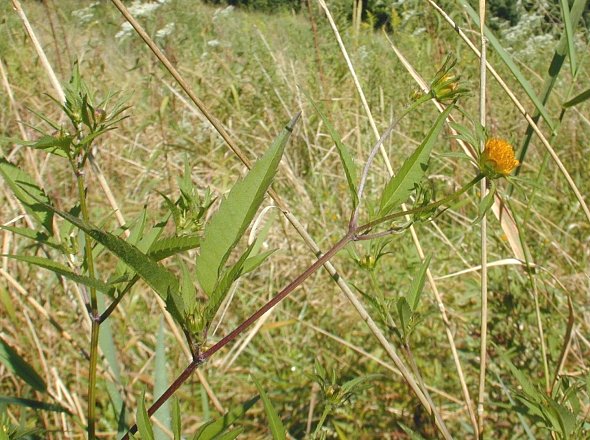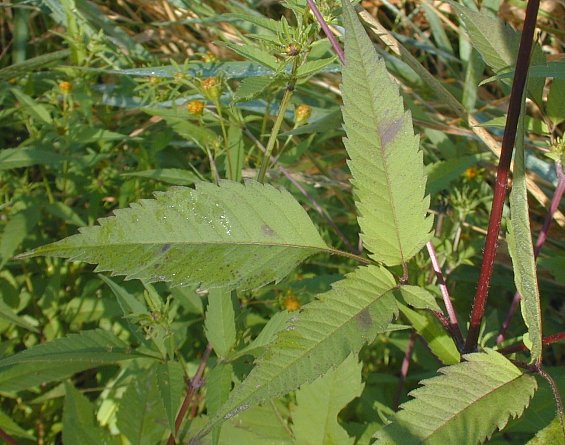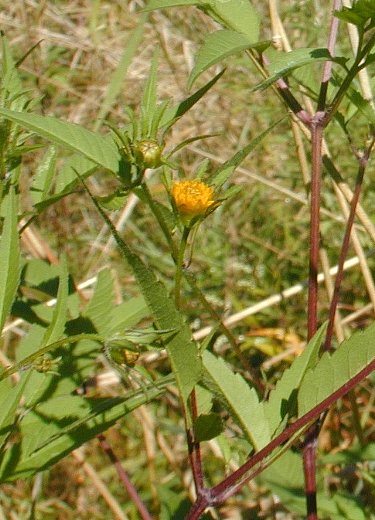Description: This annual plant is 1-3' tall, branching occasionally in the upper half. The stems are glabrous or they have a few scattered white hairs; they are often purple in bright sunlight, otherwise light green or reddish green. The compound leaves are usually odd-pinnate, consisting of 3 or 5 leaflets. Often, there are simple leaves near the flowerheads. These leaves occur oppositely along the stems, although some of the upper leaves may be alternate. The compound leaves have long petioles. The leaflets are up to 3" long and 1" across. They are lanceolate, coarsely serrated, and usually hairless, although their lower surface may be slightly pubescent. The tips of the leaflets are rather long and pointed. Some of the upper stems terminate in individual flowerheads about ¾–1" across on long stalks; some stalks may have 1-2 additional flowerheads that are smaller in size. The flowerheads consist of numerous disk florets that have golden yellow corollas; petaloid rays are absent. The flowerhead bases are surrounded by 6-10 leaf-like outer bracts (phyllaries); they are usually 8 in number. These narrow bracts are green and slightly ciliate. The blooming period occurs from late summer to early fall, lasting about 1-2 months. There is no noticeable floral scent. The dark achenes are flattened, each one terminating in a pair of long and slender awns. These awns have tiny barbs that point downward. Because of their light weight, the achenes can be blown about by wind. The root system consists of a shallow taproot that branches frequently. During the autumn, the leaves often turn purple.

Cultivation:
The
preference is partial to full sun and moist conditions; light shade is
also tolerated. The soil should be reasonably fertile, with sufficient
organic
material to retain moisture. Occasional flooding and poor drainage is
tolerated, if not preferred. This plant is easy to grow, often becoming
a weedy pest. Sometimes it is found in more mesic situations, but
individual plants will be smaller in size and less robust.
Range & Habitat:
The native Common Beggar-Ticks occurs in most counties of Illinois, and
it is
quite common; official records probably underestimate its distribution
in
some areas (see Distribution
Map). Habitats include moist areas of black soil prairies,
moist meadows near woodlands or rivers, openings in floodplain
woodlands and young
flatwoods, thickets, marshes, swamps, seeps, borders of ponds
or
lakes, poorly drained areas along railroads and roadsides, both
cultivated
and abandoned fields, banks of drainage canals, and miscellaneous waste
areas.
This plant likes disturbed areas.

Faunal Associations: The nectar of the flowers attract fewer insects than Bidens spp. with showier flowers. Occasionally, they are visited by bumblebees, Halictid bees, wasps, bee flies, Tachinid flies, small butterflies, and other insects. The caterpillars of several species of moths feed on the foliage, pith of the stems, or flowerheads, including Epiblema otiosana (Bidens Borer Moth), Platysenta mobilis (Mobile Groundling), Condica confederata (The Confederate), Cirrophanus triangulifer (Goldenrod Stowaway), and Palthis asopialis (Faint-Spotted Palthis). Other insects that feed on this plant include the leaf beetles Calligrapha bidenticola and Calligrapha californica, larvae of the leaf-miner flies Chromatomyia syngensiae and Phytobia allecta, and several aphid species. The seeds are eaten by small rodents and various birds, including the Ring-Necked Pheasant, Bobwhite, Swamp Sparrow, and Purple Finch. The Cottontail Rabbit occasionally eats the foliage. The awns of the seeds readily cling to the fur of animals and clothing of humans, thereby spreading this plant far and wide.

Photographic
Location:
The photographs were taken near a drainage ditch at Judge
Webber Park in Urbana, Illinois.
Comments:
This is one of the more common Bidens spp. The
species in this genus can be divided into two groups: those with showy
flowers and those with non-showy flowers. Common Beggar-Ticks is a
member of the latter group. The non-showy Bidens spp.
in Illinois can be distinguished from each other by considering two
characteristics: 1) whether most of the leaves are simple or pinnately
compound, and 2) the number of outer bracts surrounding the
flowerheads. Common Beggar-Ticks has pinnately compound leaves and
about 8 outer bracts surrounding its flowerheads. It is quite
similar in appearance to Bidens vulgata (Tall
Beggar-Ticks), except that this latter plant has about 13
outer bracts surrounding its flowerheads.